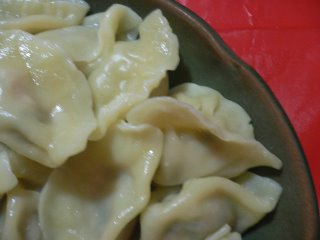Symbolic foods are a large part of Chinese New Year. Fish is eaten, because the Chinese word for fish “yu” sounds the same word as abundance. Jiaozi, a boiled dumpling, are eaten for the New Year because their shape harks back to ancient Chinese money, gold and silver ingots to be exact. Another reason is that the words Jiaozi literally means to sleep together and have sons, a much desired fate amongst Chinese. Prawns represent laughter because of the shape whereas Nian Gao, a sticky rice cake, will bring you both “Year High” or a good year and good fortune as its stickiness ensures that good things will “stick” to you. As my dad hails from the Shandong province in Northern China, I am particularly fond of dumplings, a staple of this region. So here I share my recipe for this New Year’s treat.
 Jiaozi
JiaoziFor dough
1 3/4 to 2 cups all-purpose flour
3/4 cup cold water
For filling
1 lb ground pork (not too lean)
1/2 to 1cup water
2 tablespoons soy sauce
2 tablespoons Shaoshing wine (or dry sherry)
1 tablespoon toasted sesame oil
1 tablespoon minced peeled fresh ginger
1/2 cup minced green onion
3 tablespoons minced fresh cilantro
2 cups grated zucchini (2-3 whole ones)
Salt, if needed
For dipping sauce:
1/2 cup soy sauce
2 tbsp. Chinese black vinegar or rice vinegar
1 tsp. sesame oil
3 tablespoons green onion
3 tablespoons minced fresh cilantro
1 teaspoon of chili paste or oil (optional)
Special equipment: a 6-inch (3/4-inch-diameter) rolling pin or dowel
A large pot in which to cook the dumplings
Make dough:
Put 1 3/4 cups flour in a large bowl, then add water, stirring with a wooden spoon until a shaggy dough forms. Turn out dough (including any loose flour) onto a work surface and knead, incorporating some of remaining 1/4 cup flour if dough is sticky, until smooth, about 5 minutes.
Form into a ball and wrap in plastic wrap. Let stand at room temperature at least 30 minutes.
Make filling while dough stands:
Put the ground pork in a bowl, and start mixing a bit of water in, stirring in one direction only. Chopsticks are ideal stirring implements. Continue adding water, the soy sauce and the wine and stirring all the while until the mixture looks a bit sticky. You may not need all the water. At this point, mix in the sesame oil, ginger, green onions, cilantro and zucchini and salt if needed. Fry off a little patty to check seasoning; it should be highly seasoned as wrappers have none.
After the dough has rested, continue kneading 5 more minutes on a lightly floured surface. The dough should be elastic, smooth and not sticky. Roll the dough into an even rope about 15 inches long. Cut the rope into 1/2-inch pieces to form about 30 pieces. Roll each piece into a ball. Flatten each ball with a rolling pin that has been lightly dusted with flour into 3-inch rounds, rolling from the center to the edges, making the center slightly thicker and the edges thinner. Cover all unused dough with a slightly damp cloth.
Line a baking sheet with a parchment paper or dust with flour. Work on 1 dumpling at a time, keeping the remaining wrappers covered with plastic wrap. Place about 2 teaspoons of filling in the middle of a wrapper. Starting at one end, seal the dumpling together by pleating and squeezing to form a crescent shape. Place filled dumpling on the prepared baking sheet and cover with plastic wrap. Repeat with remaining ingredients until all the wrappers are filled.
Bring large pot of water to boil. Add enough jiaozi to cover the base of the pot about 1.5 times, stirring to make sure none stick to the base of the pot. Cover.
When it comes to a boil, add 1 cup cold water. Cover. Repeat. When it comes to a boil for the third time, they are ready to serve.
Note: if you stop it before the third boil, the meat will not be cooked through. Also, if you don't add cold water each time, the jiaozi will fill up with air and explode.
Make dipping sauce:
Combine vinegar, soy sauce sesame, onions, cilantro and chili, if using.
TO KEEP:
You can freeze uncooked dumplings for later use. Freeze dumplings separately on cookie sheets until firm, then put them in plastic bags. When cooking from frozen, cook exactly the same way.

3 comments:
Wow, that is one of the most detailed jiaozi recipes I've ever seen. Thanks for that. I've gotten so used to getting jiaozi around the next food court or restaurants that I've not made any in years! This is making me wanna try again.
Thank you for sharing your recipe. I am embarrassed to admit that I served frozen ones at our lunar new year dinner...even though I've made them from scratch with my mom, I've never done it alone since she always seems to make up the recipe as she goes, a dash of this, etc. Anyhow, I will have to try your recipe next year. Happy Year of the Dog!
Hey MM, yes jiaozi making seems like a long and complicated process, but once you give it a try you will see that it is not such a big deal. And so worth the effort!
Carol, don't be embarassed, you served dumplings that's the important thing. And dumplings are a "make it up as you go along" type of recipe. Mine never seem to turn out the same way twice, but no one ever complains ;-) Give it a try, they'll be great.
Post a Comment